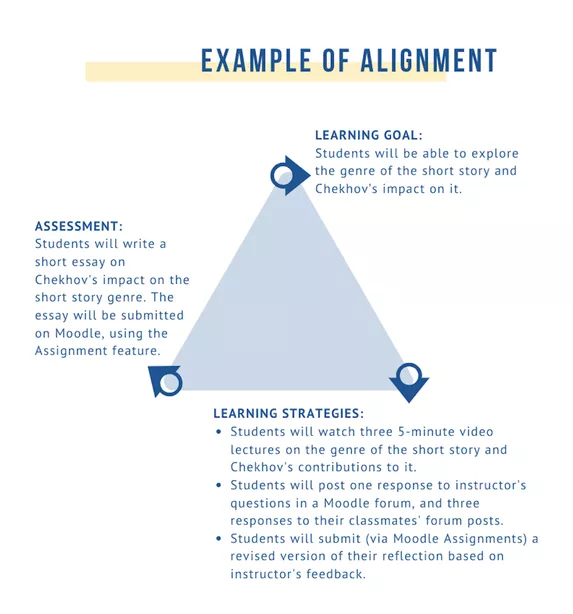
As with every in-person class, online learning begins with a plan. In this quick guide, we will walk you through the steps of pedagogical planning that are most useful when first thinking of moving a course online, including aligning goals, strategies, and assessment, and choosing resources and learning tools.
Aligning goals, strategies, and assessment
Pedagogical planning requires aligning three key elements. The first element is a learning goal/objective. This should be a measurable outcome determined by the instructor and based on what students should achieve at the end of the lesson. Having set up clear learning objectives, the next element comes into play: learning strategies. Ideally, more than one learning strategy is aligned with each learning objective. The purpose of this is to give students plenty of opportunities to practice and master what the instructor needs them to achieve. Finally, one or more assessments should be in place for students to show evidence of their progress toward the learning objective.
Learning goals
Just as with in-person learning, when you think of your lesson's learning goals, think of them as measurable or visible outcomes. As you write up your goals, consider how you will gather evidence for each outcome. Keep in mind you must use online technologies to gather evidence of your students' learning process.
Learning strategies
Learning strategies involve the opportunities students will have to engage with and master the content or skills. Strategies should trace a clear path to students achieving the learning goals you have set up. In online learning, it is key to remember that many strategies will not take place in front of the instructor or even classmates–the key is to give students sufficient opportunity and support to learn on their own.
Assessment
Your assessments should bring together your learning goals and teaching strategies. When designing assessments, choose technologies or platforms that will provide the most evidence of learning goals possible with the least interference of technology. Remember: your goal is to assess students' learning, not their mastery of tech tools.
Choosing your technologies
When teaching online, many instructors feel overwhelmed by the vast amount of tech tools, software, and apps that are available to them and their students. However, online teaching and teaching with tech are all about using technology to improve the learning process, not to hold it back. Complex tech tools should only be used when they are absolutely necessary to achieve learning goals. In every case, it is crucial to direct students' cognitive capacity toward achieving learning objectives and not toward figuring out complicated, perhaps unnecessary platforms.
Capitalize on your current repertoire of tech tools, and only go outside the familiar when you and your students feel ready to go outside your comfort zone. The best tools for online teaching are those with which you and your students are already familiar.
